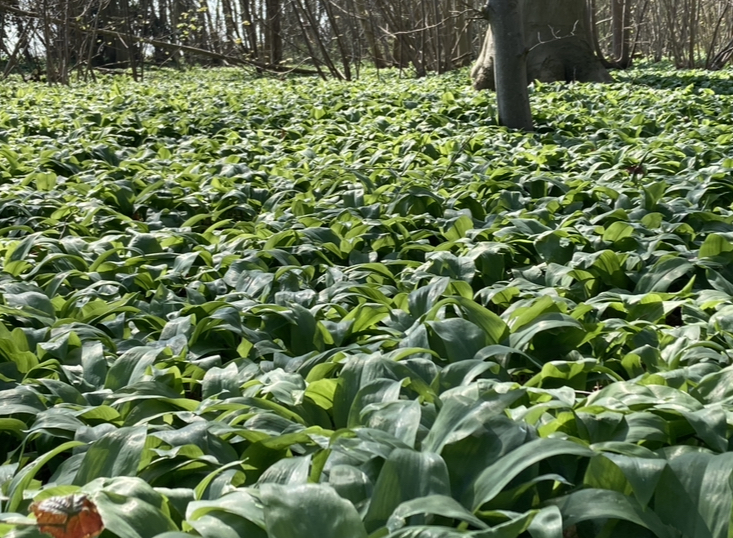Wild Garlic Soup Tans Way
Taking a long walk on A beautiful Easter Sunday from my mother’s house in Kent. The usual picture postcard scenes of lambs and bunnies bounding across bright pastures of greenness, yellow primroses, celandines, and catkins.
As we strolled through the woodland, stepping in time to birdsong, James scoured the ground for the elusive morel mushrooms, and I headed straight for a carpet of ramsons otherwise known as wild garlic. Unlike James, I knew where to look for my foraged treasure, as this terrain had been my playground, where as a child I would make camps and climb trees. Returning home at the end of the day stinking of moss, soil, and wild garlic depending on the season.
Back then we didn’t forage for anything other than blackberries and beechnuts, probably due to some wartime hangover, where country folk didn’t want to be reminded of hunger and hardship. So, I was totally unaware of what delicious, edible greens I was romping around in.
We approached a vast blanket of ramsons, a carpet of verdant green fronds spreading lusciously across the forest floor. Their white flowers were yet to bloom but they were ripe for the picking and so many of them, more than enough to share between myself and the woodland Nyad’s. We headed home with a full aromatic sack yet James on the other hand, still with a very empty trug, as the morels had eluded him once again.
My son Reuben, an experienced chef, was also in residence, visiting his grandmother that weekend and was full of ideas for how to use our bounty.
Firstly, we washed and drained most of them, checking to see if there were any foreign bodies appearing in the water including any Lilly of the Valley or Lords and Ladies that I’d overlooked when picking. These poisonous plants have a similar colour to the wild garlic and like to grow amidst the crop so it’s best to keep a careful eye out when foraging. A way to be sure is to crush the leaves as ramsons smell of onions and the others do not. For more information on poisonous plants in the UK go to the Woodland Trust website.
Then we blanched the bulk, including the stems, in salty water for approximately 3 minutes. Once drained I put some aside to freeze and with the other Reuben set out to make several delectable dishes including wild garlic and walnut pesto, hummus, garlic butter and my favourite, wild garlic soup!
For me this pungent aromatic soup is a taste of spring, fresh and vibrant, a hearty bowl of optimism. Reuben, who is a master of resourceful cooking, having worked as a chef at St John’s Bread and Wine restaurant for four years, set about making us the most nourishing post-forage lunch.
How to make wild garlic soup:
Ingredients:
· Wild garlic leaves, about a shopping bag full
· A large white onion, finely chopped
· Vegetable bouillon or chicken stock Potatoes six medium sized, peeled
· Salt/Pepper
Method:
Sweat the onion in olive oil for as long as possible, not allowing it to brown, just until they become soft and transparent. Now add the potatoes and cover with the stock. Once they are parboiled add the leaves and simmer for a further 10 minutes.
Now add a drizzle of olive oil and puree the ingredients with a stick blender or a food processor. Drizzle with some more olive oil and serve with croutons, and a teaspoon of wild garlic pesto.
Reuben’s tips:
· Serve with sourdough bread, or warm rolls.
· Add finely chopped spring greens for texture like nettles.
· This soup can be beautifully enhanced by adding some grated parmesan cheese.
· It also goes well with some freshly picked morels if you can find them.
· This soup can be frozen and rolled out for a fine winter warmer.
·
Some facts about Wild Garlic:
The scientific latin name is Allium ursinum because brown bears loved to eat the bulbs. This was reflected in some of its common names, bear’s garlic, and bear leek. Other names for this ancient alium are ramson, wild garlic, broad-leaved garlic, buckram, wood garlic.
The second half of the Latin name, ursinum, refers to the fact that brown bears loved to eat the bulb. This also gave rise to two of its common names – bear’s leek and bear garlic. On the other hand, this plant is known to repel cats who don’t seem to care for the smell at all.
Wild garlic grows from bulbs and spreads through woodland in spring and has a distinctive garlicky smell. The leaves are pointed, long, with toothed edges and the flowers are small and white with a thin leafless stalk and six petals. The flowers are an important early source for bees and other pollinating insects and the bulbs are a delicacy for wild boars.
You can find wild garlic in deciduous woodland, preferring damp chalky soil. It is often an indicator of ancient woodland, and a special hallowed space to be standing on. In turn the ramson has been used throughout the ages for its medicinal properties, particularly the bulbs to treat cholesterol and rheumatic problems.
To learn more about ancient woodland go to the woodland trust website: https://www.woodlandtrust.org.uk/trees-woods-and-wildlife/habitats/ancient-woodland/
And to learn more about poisonous plants in the UK go to: https://www.woodlandtrust.org.uk/blog/2020/07/uk-poisonous-plants/
Please note, wild garlic leaves are legal to forage but not the roots.
Tan

No responses yet